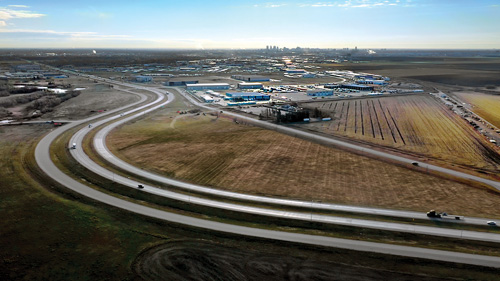Canadian Industrial Sectors Expand with Business and Government Investment
Diverse public-sector infrastructure investments, streamlined regulations, and certified site programs are driving private-sector industrial investment and expansions across Canada.
Location Canada 2021

In April 2021, a new ranking by U.S. News & World Report and BAV Group made the headlines naming Canada the “Best Country” in the world. In addition to the Quality of Life and Social Purpose categories for which Canada ranked first out of 78 countries, Agility and being Open for Business were also strong showings for Canada with third-place rankings overall. These are simple indicators of the momentum that has been building in a wide range of industrial sectors across the country, supported by diverse infrastructure investments by governments at all levels.
Agility: Federal governments are rarely considered to be agile but strong alignment within successive Canadian governments regarding the importance of infrastructure investment has allowed Canada to advance its investment strategies and adjust to regional and industry needs. Today, the industrial economy is supported by infrastructure investments led by two arms of the federal government: the Ministry of Infrastructure and Communities and the relatively new Canada Infrastructure Bank (CIB).
Through the Investing in Canada Plan, launched in 2016, the government of Canada committed $180 billion over 12 years for infrastructure. To date, the plan has invested over $96 billion in over 73,000 projects, 95 percent of them completed or under way. The Investing in Canada Plan delivers investments across five broad streams: public transit, green, social, rural and northern communities, and trade and transportation. As in many countries, Canada has taken a wide-angled perspective on the definition of “infrastructure” with overall objectives to promote economic growth and jobs, support resilience and a low-carbon economy, and build inclusive communities. Still, the “hard concrete” projects are getting done, with more than $14 billion devoted to projects related to national infrastructure, major regional projects, national trade corridors, and other provincial and municipal infrastructure priorities.
The Canada Infrastructure Bank (CIB) has a unique authority to contribute to infrastructure projects through equity investments, loans, and loan guarantees. The Canada Infrastructure Bank (CIB) also has a unique authority to contribute to infrastructure projects through equity investments, loans, and loan guarantees to promote public-private partnerships and accelerate new investment. Projects that have been approved or are already under way — 24 projects as of July 2021 — include the Port of Montreal’s expansion, the indigenous-owned Tshiuetin Railway in northern Quebec and Labrador, hydroelectric grid expansions in Nunavut and the Northwest Territories, broadband expansion for different rural communities in multiple provinces, a 250-megawatt energy storage project in southwestern Ontario, and major highway and bridge replacements or expansions in key supply chain markets and corridors.
For certain key infrastructure projects around the country, the focus on community support to achieve public approvals has evolved to include the community’s active participation in the project. First Nations, in particular, must be meaningfully engaged as stakeholders and will be increasingly involved in select projects as investment partners, strategic suppliers, or as a workforce to be trained and deployed. This reflects Canada’s passage of a law implementing the United Nations Declaration on the Rights of Indigenous Peoples and a broader orientation toward pursuing inclusive economic growth.
Open for Business: While it is commonly accepted that Canada is open for business, different elements have put that to the test recently. Lengthy delays and uncertain processes for major project permitting can be a challenge, especially for infrastructure and energy-related projects. Lack of redundancy and optionality for certain transportation corridors remains a latent supply chain risk. And natural hazard risks like forest fires and floods have caused increasing frequency or intensity of periodic regional business disruptions. The good news is that the country is taking steps to address these issues and has further increased its efforts in the wake of the pandemic.
Through investments by three levels of government and through public-private partnerships, Canada is advancing its industrial agenda across the country. Project funding is improving core infrastructure, addressing climate change with investments in renewable energy, supporting First Nations’ unique infrastructure challenges, adding rail tracks and roads, expanding broadband service, and growing cargo freight capacities at ocean, air, and ground hubs.
Supporting private investment through streamlined regulatory procedures and improved investment readiness is also a key ingredient to being open for business. What comes next for the infrastructure evolution is a deeper connection between tangible assets and data analytics and machine learning. This explains the Canadian government’s launch of Scale.ai in 2018. Part of a broader superclusters’ initiative, Scale.ai is a group of supply chain operators, solution providers, and digital technology experts partnering in collaborative projects that improve the efficiency of supply chains using artificial intelligence and machine learning. Close to 30 projects across the country have been funded so far, addressing challenges in the retail, mining, food, manufacturing, transportation, and aerospace industries.
Supporting private investment through streamlined regulatory procedures and improved investment readiness is also a key ingredient to being open for business. For example, the government of Ontario, has put several strategic measures and programs in place to further support global investors who are looking for their next business expansion location. After creating Invest Ontario, an investment attraction agency with a dedicated fund to help secure strategic investment opportunities, the province recently launched Canada’s first mega industrial site initiative. Ontario’s Job Site Challenge will identify suitable mega sites for very large manufacturing investments. Newmark has the privilege to be supporting the province and local communities with this initiative to help them compete with other mega-site programs popular — and successful — in the United States.
The Job Site Challenge builds on the province’s existing Investment Ready: Certified Site Program, launched in 2013. This program facilitates site development pre-qualification for investors and site consultants. The Atlantic provinces and Quebec similarly launched certified site programs in the last year. Ontario, however, seeks to remain one step ahead by launching a new Site Readiness Program this fall to support smaller sites by undertaking advanced due diligence and site preparation work for investors, thereby reducing their development burden.
Private-Sector Momentum: Around these public-sector infrastructure and policy initiatives is the private sector, which continues to drive industrial investment and expansion. One major Canadian electric utility executive recently said privately that he has not seen so many large project initiatives in his 30 years in the industry.
Every major metro outside of the prairies have industrial real estate availability rates of 3 percent or less. This volume of project initiatives is reflected in the general industrial real estate market conditions around the country, where every major metro outside of the prairies has availability rates of 3 percent or less, including the three largest markets of Toronto (1.2 percent), Vancouver (1.1 percent), and Montreal (1.4 percent). Overall, Canadian banks are healthy, lenders are well-capitalized, and funds are available to support industrial property growth. If anything, municipalities and utilities would benefit from accelerating their development/capital planning and approvals so new industrial construction can catch up with burgeoning demand for manufacturing, flex industrial, and distribution space, whether speculative or build-to-suit product.
Good news industrial stories abound throughout the country. CN Rail is investing $250 million at a new logistics hub in Milton, Ontario. A private developer continues to offer new sites and vertical construction alongside a new rail park served by three Class 1 railroads at CentrePort in Winnipeg, Manitoba. More than $1.5 billion in new life science projects have been recently announced in Ontario’s Greater Toronto area. The list of large and creative developments is lengthy, from Canada’s first multi-story industrial warehouse in the Greater Vancouver area, to an Amazon pickup depot in Iqaluit that connects a remote population to products from the rest of the world. Other examples include the world’s first net-zero hydrogen production facility announced in Edmonton, Alberta, and Lion Electric’s new production facility in Montreal, Quebec, where it makes electric trucks and school buses and will soon add battery manufacturing capacity.
From the Pacific to the Atlantic to the Arctic, the development of next-generation infrastructure and industrial projects in Canada is creating a new and interesting future.
Project Announcements
Swiss-Based Hitachi Energy Expands Varennes, Canada, Operations
10/14/2025
Northern Transformer Plans Innisfil, Ontario, Canada, Manufacturing Operations
10/02/2025
Ranovus Expands Ottawa, Ontario, Semiconductor Operations
08/29/2025
Canada-Based Mancuso Chemicals Plans Pachuta, Mississippi, Logistics-Distribution Operations
08/11/2025
Ferrero Expands Brantford, Ontario, Canada, Production Operations
04/19/2025
Minth Group Plans Windsor, Ontario, Canada, Manufacturing Operations
04/07/2025
Most Read
-
The Workforce Bottleneck in America’s Manufacturing Revival
Q4 2025
-
Rethinking Local Governments Through Consolidation and Choice
Q3 2025
-
First Person: Filter King’s Expansion Playbook
Q3 2025
-
Lead with Facts, Land the Deal
Q3 2025
-
How Canada Stays Competitive
Q3 2025
-
Investors Seek Shelter in Food-Focused Real Estate
Q3 2025
-
America’s Aerospace Reboot
Q3 2025

